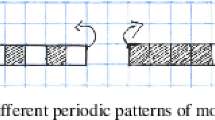Abstract
It is shown that Turing’s theory of morphogenesis and Rashevsky’s two-factor models are closely related, both being instances of diffusion-reaction schemes. It is further shown that the morphogenetic character of such schemes invariably gives rise to an apparent active transport, and indeed that it is on this transport that the morphogenetic properties of reaction-diffusion models depends. Some relations between the above and two-factor descriptions of other biological processes are briefly discussed.
Similar content being viewed by others
Literature
Fitzhugh, R. 1955. “Mathematical Models of Threshold Phenomena in the Nerve Membrane.”Bull. Math. Biophysics,17, 257–278.
Hill, A. V. 1935. “Advances of Modern Biology.” (Biomedgiz, Moscow, USSR),4, 131.
— 1936Proc. Roy. Soc. London,B,120, 389.
Karreman, G. 1951. “Contributions to the Mathematical Biology of Excitation with Particular Emphasis on Changes in Membrane Permeability and on Threshold Phenomena.”Bull. Math. Biophysics,13, 189–243.
Rashevsky, N. 1933. “Outline of a Physico-Mathematical Theory of Excitation and Inhibition.Protoplasma,20, 42.
— 1939. “On the So Called Plasticity of the Central Nervous System.”Bull. Math. Biophysics,1, 93–94.
Rashevsky, N. 1940a. “An Approach to the Mathematical Biophysics of Biological Self-Regulation and of Cell Polarity.”Ibid.,2, 15–25.
— 1940b. “Contributions to the Mathematical Biophysics of Organic Form. I. Formation of Cavities in Cellular Aggregates.Ibid.,2, 27–36.
— 1940c. “Further Contributions to the Theory of Cell Polarity and Self-Regulation.Ibid.,2, 65–67.
— 1940d. “Contributions to the Mathematical Theory of Organic Form II. Asymmetsic Metabolim of Cellular Aggregates,”Ibid.,2, 69–72.
— 1940e. “Physicomathematical Aspects of Some Problems of Organic Form.Ibid.,2, 109–121.
— 1940f. “Contributions to the Mathematical Biophysics of Organic Form III. Deformation of Shell Shaped Cellular Aggregates,”Ibid.,2, 123–126.
— 1960.Mathematical Biophysics, New York: Dover Publications.
Rosen, R. 1959. “A Quantum-Theoretic Approach to Genetic Problems.”Bull. Math. Biophysics,22, 227–255.
— 1966. “Biological and Physical Realizations of Abstract Metabolic Models.”Helgoländer Wiss. Meeresunters,14, 25–31.
— 1967. “Two-Factor Models, Neural Nets and Biochemical Automata.”J. Theoret. Biol.,15, 282–297.
Rosen, R. 1968a. “Recent Developments in the Theory of Control and Regulation of Cellular Processes.”Int. Revs. of Cytology, to appear.
— 1968b. “On Analogous Systems.”Bull. Math. Biophysics,30, 481–492.
Turing, A. M. 1952. “The Chemical Basis of Morphogenesis,”Phil. Trans. Roy. Soc. London,B,237, 37–94.
Author information
Authors and Affiliations
Rights and permissions
About this article
Cite this article
Rosen, R. Turing’s morphogens, two-factor systems and active transport. Bulletin of Mathematical Biophysics 30, 493–499 (1968). https://doi.org/10.1007/BF02476609
Received:
Issue Date:
DOI: https://doi.org/10.1007/BF02476609




